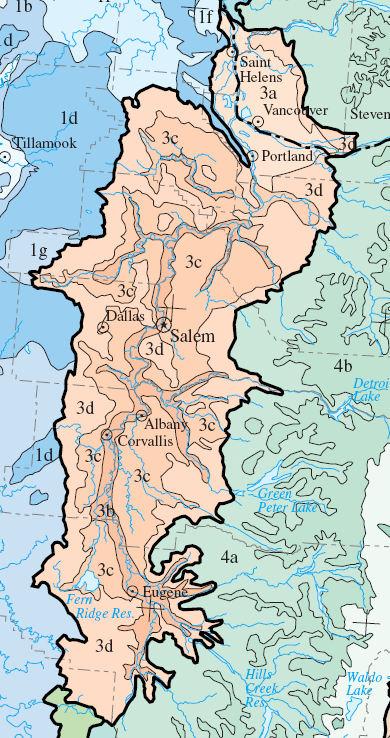So I have decided that I want and need to come at a Willamette River Civilization for the Pacific Northwest once again and from a different, more realistic beginning POD. I'll keep elements of the previous TL but I want to diverge and see where this one can be taken, so I present to you:
Land of Salmon and Totems 2.0
-----------------------
Identification of the “River Potato”
In truth this plant does not have any relation to the Solanum Tuberosum or the Common Potato that originated in the Andes, it is called the Aquaflmen Tuberosum based off its origin in the Oregon Country Rivers and its nature of spring from the river. The only relation is probably based in the roughly similar size of the nutritional portion of the plant and that it is a tuber.
The plant itself starts with light green seeds the size of a dime which are noted for having a resilient inner shell while a buoyant outer shell which allows for perseverance in cold winters and to spread along river banks as drift seeds. Once rooted into riverbank soil the seed grows roots that keep it planted in the soil while absorbing passing oxygen and nutrients from the river water. This is key as it does poorly in stagnant water which does not allow for a moving filter motion except for a few lake cases and human created irrigation systems. The River Potato grows up as a dark green stalk in different lengths with the tallest being six feet, the tip being a flower with six blue-white, oval shaped flowers one to five inches in length. The River Potato also has the nickname of the "Totem Flower" because of its upstraight structure and earlier ownership of crops extended to the entire kinship group. The storage organ where the carbohydrate energy is stored is what is known as the ‘potato’ sprouts from the flower and over the course of its development it grows to the size of a fist, drooping the stalk of the plant as it grows. The complexion is orange-brownish complexion which in dryer climates becomes redder in hue.
The origin of the name could be traced to the personal journal of Sir Francis Drake who arguably was the first European to see the plant from its source when he visited the trade port of Clatsop before his fateful journey down the Columbia River. Californian variants of the River Potato were possibly encountered by Spanish explorers but no records have been found of any realizing the difference. From its origin on the Columbia River before European contact it would be spread by native sources down to the Willamette River and into California then following European contact becoming widespread from Europe to Asia existing in Continental climate zones to Subtropical climate zones.
Without this crop it is highly unlikely that the Oregon Civilization could not have arose from the banks of the Columbia and Willamette river to create a bronze age civilization existing in the Pacific Northwest which would outlast its East North American, Mesoamerican, and Andean counterparts as centers of native civilization.
Land of Salmon and Totems 2.0
-----------------------
Identification of the “River Potato”
In truth this plant does not have any relation to the Solanum Tuberosum or the Common Potato that originated in the Andes, it is called the Aquaflmen Tuberosum based off its origin in the Oregon Country Rivers and its nature of spring from the river. The only relation is probably based in the roughly similar size of the nutritional portion of the plant and that it is a tuber.
The plant itself starts with light green seeds the size of a dime which are noted for having a resilient inner shell while a buoyant outer shell which allows for perseverance in cold winters and to spread along river banks as drift seeds. Once rooted into riverbank soil the seed grows roots that keep it planted in the soil while absorbing passing oxygen and nutrients from the river water. This is key as it does poorly in stagnant water which does not allow for a moving filter motion except for a few lake cases and human created irrigation systems. The River Potato grows up as a dark green stalk in different lengths with the tallest being six feet, the tip being a flower with six blue-white, oval shaped flowers one to five inches in length. The River Potato also has the nickname of the "Totem Flower" because of its upstraight structure and earlier ownership of crops extended to the entire kinship group. The storage organ where the carbohydrate energy is stored is what is known as the ‘potato’ sprouts from the flower and over the course of its development it grows to the size of a fist, drooping the stalk of the plant as it grows. The complexion is orange-brownish complexion which in dryer climates becomes redder in hue.
The origin of the name could be traced to the personal journal of Sir Francis Drake who arguably was the first European to see the plant from its source when he visited the trade port of Clatsop before his fateful journey down the Columbia River. Californian variants of the River Potato were possibly encountered by Spanish explorers but no records have been found of any realizing the difference. From its origin on the Columbia River before European contact it would be spread by native sources down to the Willamette River and into California then following European contact becoming widespread from Europe to Asia existing in Continental climate zones to Subtropical climate zones.
Without this crop it is highly unlikely that the Oregon Civilization could not have arose from the banks of the Columbia and Willamette river to create a bronze age civilization existing in the Pacific Northwest which would outlast its East North American, Mesoamerican, and Andean counterparts as centers of native civilization.

